Key facts about ratios
Ratios: Show the relationship between two quantities, like the teacher to student ratio in a class.
Purpose in business: Ratios help analyse a company's performance, liquidity, and overall health.
Big five ratios: Gross profit percentage, net profit percentage, inventory turnover rate, return on capital employed (ROCE), and working capital ratio.
Importance: Different groups (owners, banks, customers, employees, suppliers, local residents) use ratios to assess various aspects of a business, like investment returns, loan repayment, job security, and business viability.
What are ratios? What do they show?
A ratio is a formula showing the relationship between two quantities.
For example, in a Business Studies class the teacher to student ratio could be 1: 25.
We could also state this as a percentage:
\(\frac {\text{No. of teachers}} {\text{No. of students}} \times \frac {100} {1} = 4\%\)
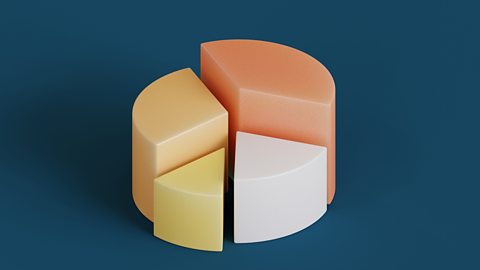
In business, what is the purpose of ratios?
In accounting, ratios are used to help analyse a company’s:
Performance: How well is the business being run? Are the management doing a good job? Are the shareholders’ funds being properly used?
Liquidity: Can the business pay its short-term debts?
General health: Is the firm a good investment opportunity?
| Group | Reason for interest? |
|---|---|
| The owners of the business | • return on their investment? |
| Banks | • should they lend? • will they get their money back? • when will they get their money back? |
| Customers | • profit levels: why are they charging so much? • will they survive long enough to deliver? |
| Employees | • do they have job security? • can they get a pay rise? |
| Suppliers | • will they get paid? • when? |
| Local residents | • can they get a job? • will their business be running 24 hours a day creating noise during the night? |
What are the big five ratios?
- Gross profit percentage
- Net profit percentage
- Inventory (stock) turnover rate
- Return on capital employed
- Working capital ratio (also called current ratio)
What is gross profit percentage (also called gross profit margin)?
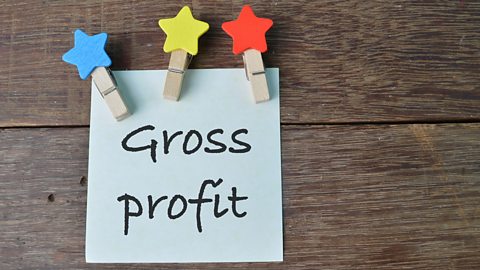
The formula
\(\frac {\text{Gross profit}} {\text{Sales turnover}} \times {100}\)
This shows what proportion of sales revenue is gross profit (profit made after only the direct costs of production, such as raw materials, have been deducted).
If a furniture shop takes a cost of sales (materials, packaging) of £2000 away from a sales turnover figure of £5000 it is left with a net profit of £3000:

\(\frac {\text{Gross profit}} {\text{Sales turnover}} \times {100} = \frac {£3000} {£5000} \times {100} = 60\%\)
This shows if the firm has been able to control its costs. If gross profit margin is low, then this usually indicates one of two things:
- the business is facing strong price competition from similar businesses, and has to keep its prices very low to avoid losing customers
or
- the cost of materials has risen (eg global price of timber or leather has risen due to shortages)
If the gross margins are very low, the firm needs to look at ways of reducing its direct costs, such as finding a cheaper supplier.
What is a “good’ number?
It depends on the industry. A sports clothing retailer could have gross profit margins of about 50%, whereas a supermarket chain would have gross margins of around 10%.
So:
Compare this year’s gross profit percentage with last year’s. Is it better, or worse?
Compare this year’s gross profit percentage with a competitor in the same industry. Is yours better, or worse?

What is net profit percentage (also called net profit margin)?

The formula
\(\frac {\text{Net profit}} {\text{Sales turnover}} \times {100}\)
This shows what proportion of sales revenue is net profit (profit made after all overhead expenses have been deducted). In the example of a furniture shop, overheads of £2500 are taken away from a gross profit of £3000 leaving a net profit of £500:
\(\frac {\text{Net profit}} {\text{Sales turnover}} \times {100} = \frac {£500} {£5000} \times {100} = 10\%\)

This shows if the firm has been able to control its costs. If net profit margin is low, then the firm needs to look at ways of reducing its costs.
What is a “good’ number?
It depends on the industry. A sports clothing retailer could have net profit margins of about 10%, whereas a supermarket chain would have very low net margins of between 1% and 5%.
So:
Compare this year’s gross profit percentage with last year’s. Is it better, or worse?
Compare this year’s gross profit percentage with a competitor in the same industry. Is yours better, or worse?

What is inventory turnover rate (also called stock turnover rate)?
The formula
\(\frac {\text{Cost of sales}} {\text{Average stock}}\)

How do we calculate average stock?
Average level of inventory = (opening inventory + closing inventory) / 2
So for example, suppose a firm had opening inventory worth £3,200 at the beginning of the trading period, and at the end had £1,300 as a value for closing inventory.
Average stock = (opening inventory + closing inventory) / 2
= (£3,200 + £1,300) / 2
= £4,500 / 2
Average stock = £2,250

It is expensive to hold goods as stock. The firm often has to pay for the goods before it has sold them.
Even if the goods have been sold, the seller may not have received payment for them before the original supplier needs to be paid
Having too much money tied up in stock can be a problem.
Assume the average level of stock shown on the company balance sheet is £2250.
Also assume that cost of sales is £2000.
Inventory turnover formula:
\(\frac {\text{Cost of sales}} {\text{Average stock}} = \frac {£2000} {£2250} = 0.9~ \text{times per year}\)
This is a low number, and it means that the firm is taking a long time to sell its inventory, or is holding too much inventory at a time. This figure can be divided into 52 weeks (or 365 days) to find the average time that goods are held in stock.
In this example, this will be 52 weeks / 0.889 which is about 58.5 weeks, which means it takes over a year to sell the contents of the shop or storeroom.
For a shipbuilder or aeroplane manufacturer, this might be reasonable, but for most firms, this would be unacceptable. For example, a shop selling fresh fruit and vegetables would need to turnover its stock about once per day!
What is a “good’ number?
Higher is generally better.
It depends on the industry. A sports clothing retailer could have inventory turnover of around ten times per year, whereas a supermarket chain would have a higher inventory turnover figure, of around 40 times per year. This would make sense, as the supermarket sells food which is perishable so has to sell it faster than a clothing company.
Also:
Compare this year’s inventory turnover with last year’s. Is it better, or worse?
Compare this year’s inventory turnover with a competitor in the same industry. Is yours better, or worse?

What is return on capital employed (ROCE)?
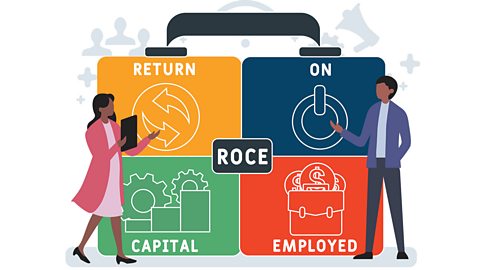
The formula
\(\frac {\text{Net profit}} {\text{Total assets - current liabilities}} \times {100}\)
ROCE tells us how much net profit is being generated from the assets of the business.
ROCE is an important figure because it tells the owners how worthwhile their investment has been. Money invested in a business can always be put to use elsewhere.

Every investment is made on a “risk versus reward” basis: considering the risk to investors in a firm (eg they can lose all of their investment) they expect to get a better return than they would in a bank or building society account. The higher return is their reward for taking on the risks of the business.
What is the purpose of ROCE?
This shows how efficiently a firm is being managed. It is very important!
It shows the annual percentage return a potential investor in the firm could expect to gain.

What is a good number?
Higher is better.
It depends on the industry. A sports clothing retailer could have ROCE of around 22%, whereas a supermarket chain would have a lower ROCE of around 8%. But the supermarket sells essential items such as food and personal hygiene products so the ROCE would tend to be steady over a number of years, whereas the sports clothing retailer is vulnerable to changes in consumer preferences and pressure from competitors, so their ROCE could fluctuate from year to year.

Also:
Compare this year’s ROCE with last year’s. Is it better, or worse compared with the current bank interest rate?
Compare this year’s ROCE with a competitor in the same industry. Is yours better, or worse?
What is working capital ratio (also called current ratio)?
The formula
\(\frac {\text{Current assets}} {\text{Current liabilities}}\)
The working capital ratio (often called current ratio) shows how many times a firm could afford to pay its current liabilities out of its current assets; eg can it afford to pay its bills?
For example, if the furniture shop has current assets of £3000 and current liabilities of £2000, the working capital ratio would be:
£3000 : £2000
3 : 2
Working capital ratio =1.5:1
This translates as £1.50 of short-term assets for every £1 of short-term debts.
What is a good number?
Higher is better!
There is no exact “perfect” ratio, but a ratio of about 2 : 1 (about £2 of current assets for every £1 of short-term debt) is considered desirable.
If a business has a working capital ratio of 0.7 : 1, this could become a problem.
If the business had to repay its overdraft AND settle up with its suppliers and landlord at the same time, it may not have enough money to do so. This can lead to extra fees from the bank, maybe a refusal to provide further inventory from the suppliers, even eviction from the landlord. So running out of cash can lead to complete failure and closure of the business.
NOTE: This ratio is stated as a ratio, rather than as a percentage.
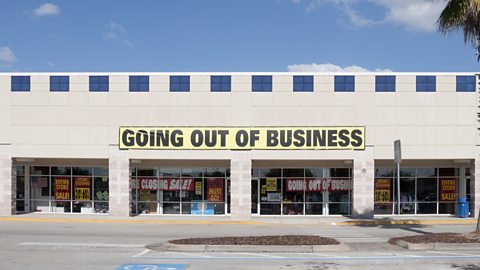
Try the ratios quiz
Use the two tables below to answer the questions that follow.
Income statement for Deadline Skateboards for the year ended 31/03/2024
| £ | £ | |
| Turnover | 360,000 | |
| Cost of sales: | ||
| Opening inventory | 13,000 | |
| Add: Purchases | 181,500 | |
| 194,500 | ||
| Less: Closing inventory | 9,500 | |
| Total cost of sales | 185,000 | |
| Gross profit | 175,000 | |
| Expenses | ||
| Rent and rates | 15,000 | |
| Electricity | 48,000 | |
| Wages | 73,000 | |
| Insurance | 12,000 | |
| Marketing costs | 6,000 | |
| Total expenses | 154,000 | |
| Net profit | 21,000 |
Statement of Financial position for Deadline Skateboards as at 31/03/2024
| Assets | ||
| Non-current assets | ||
| Machinery | 25,000 | |
| Computer equipment | 3,000 | |
| Van | 12,000 | |
| 40,000 | ||
| Current assets | ||
| Closing inventory | 9,500 | |
| Trade receivables | 6,500 | |
| Cash | 2,200 | |
| 18,200 | ||
| Total assets | 58,200 | |
| Equity | ||
| Owners' capital | 10,000 | |
| Add: Net Profit | 21,000 | |
| Total equity | 31,000 | |
| Liabilities | ||
| Current liabilities: | ||
| Overdraft | 5,000 | |
| Trade payables | 11,400 | |
| Non-current liabilities: | ||
| Loan | 10,800 | |
| Total liabilities | 27,200 | |
| Total equity and liabilities | 27,200 |

Question 1
Calculate the gross profit percentage for Deadline Skateboards?
Need a hint(Gross profit/sales turnover) x 100
\(\frac {\text{Gross profit}} {\text{Sales turnover}} \times {100}\)
\(\frac {175,000} {360,000} \times {100}\)
= 48.6%
Question 2
Calculate the net profit percentage for Deadline Skateboards?
Need a hint(Net profit / sales turnover) x 100
\(\frac {\text{Net profit}} {\text{Sales turnover}} \times {100}\)
\(\frac {21,000} {360,000} \times {100}\)
= 5.8%
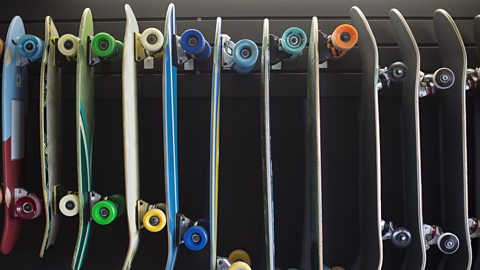
Question 3
Calculate the inventory turnover rate for Deadline Skateboards?
Need a hintCost of sales / average level of inventory
Firstly what is the average level of inventory?
Average level of inventory = (Opening Inventory + Closing Inventory) / 2.
Average level of inventory = (13,000 + 9,500) /2
Average level of inventory = 11250
\(\frac {\text{Cost of sales}} {\text{Average stock}} = \frac {185,000} {11250} = 16.4~ \text{times per year}\)
Question 4
Calculate the return on capital employed for Deadline Skateboards?
Need a hint(Net profit / (total assets - current liabilities)) x 100
\(\frac {\text{Net profit}} {\text{Total assets - current liabilities}} \times {100}\)
\(\frac {21,000} {58,200 - 16,400} \times {100}\)
= 50.2%

Question 5
What is the working capital ratio for Deadline Skateboards?
Need a hintCurrent assets \ current liability = working capital ratio
\(\frac {\text{Current assets}} {\text{Current liabilities}}\)
\(\frac {18,200} {16,400}\)
1.1:1
Final check:
What does the working capital ratio show?
The working capital ratio shows how many times a firm could afford to pay its current liabilities out of its current assets.